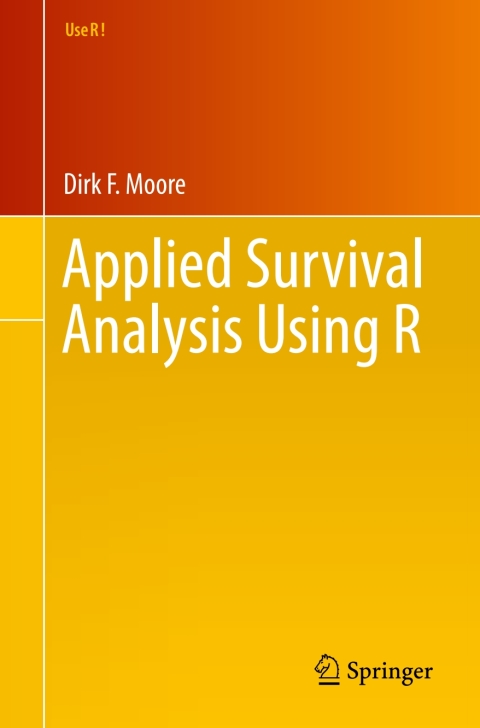Description
Efnisyfirlit
- Preface
- Contents
- 1 Introduction
- 1.1 What Is Survival Analysis?
- 1.2 What You Need to Know to Use This Book
- 1.3 Survival Data and Censoring
- 1.4 Some Examples of Survival Data Sets
- 1.5 Additional Notes
- Exercises
- 2 Basic Principles of Survival Analysis
- 2.1 The Hazard and Survival Functions
- 2.2 Other Representations of a Survival Distribution
- 2.3 Mean and Median Survival Time
- 2.4 Parametric Survival Distributions
- 2.5 Computing the Survival Function from the Hazard Function
- 2.6 A Brief Introduction to Maximum Likelihood Estimation
- 2.7 Additional Notes
- Exercises
- 3 Nonparametric Survival Curve Estimation
- 3.1 Nonparametric Estimation of the Survival Function
- 3.2 Finding the Median Survival and a Confidence Interval for the Median
- 3.3 Median Follow-Up Time
- 3.4 Obtaining a Smoothed Hazard and Survival Function Estimate
- 3.5 Left Truncation
- 3.6 Additional Notes
- Exercises
- 4 Nonparametric Comparison of Survival Distributions
- 4.1 Comparing Two Groups of Survival Times
- 4.2 Stratified Tests
- 4.3 Additional Note
- Exercises
- 5 Regression Analysis Using the Proportional Hazards Model
- 5.1 Covariates and Nonparametric Survival Models
- 5.2 Comparing Two Survival Distributions Using a Partial Likelihood Function
- 5.3 Partial Likelihood Hypothesis Tests
- 5.3.1 The Wald Test
- 5.3.2 The Score Test
- 5.3.3 The Likelihood Ratio Test
- 5.4 The Partial Likelihood with Multiple Covariates
- 5.5 Estimating the Baseline Survival Function
- 5.6 Handling of Tied Survival Times
- 5.7 Left Truncation
- 5.8 Additional Notes
- Exercises
- 6 Model Selection and Interpretation
- 6.1 Covariate Adjustment
- 6.2 Categorical and Continuous Covariates
- 6.3 Hypothesis Testing for Nested Models
- 6.4 The Akaike Information Criterion for Comparing Non-nested Models
- 6.5 Including Smooth Estimates of Continuous Covariates in a Survival Model
- 6.6 Additional Note
- Exercises
- 7 Model Diagnostics
- 7.1 Assessing Goodness of Fit Using Residuals
- 7.1.1 Martingale and Deviance Residuals
- 7.1.2 Case Deletion Residuals
- 7.2 Checking the Proportion Hazards Assumption
- 7.2.1 Log Cumulative Hazard Plots
- 7.2.2 Schoenfeld Residuals
- 7.3 Additional Note
- Exercises
- 8 Time Dependent Covariates
- 8.1 Introduction
- 8.2 Predictable Time Dependent Variables
- 8.2.1 Using the Time Transfer Function
- 8.2.2 Time Dependent Variables That Increase Linearly with Time
- 8.3 Additional Note
- Exercises
- 9 Multiple Survival Outcomes and Competing Risks
- 9.1 Clustered Survival Times and Frailty Models
- 9.1.1 Marginal Survival Models
- 9.1.2 Frailty Survival Models
- 9.1.3 Accounting for Family-Based Clusters in the “ashkenazi” Data
- 9.1.4 Accounting for Within-Person Pairing of Eye Observations in the Diabetes Data
- 9.2 Cause-Specific Hazards
- 9.2.1 Kaplan-Meier Estimation with Competing Risks
- 9.2.2 Cause-Specific Hazards and Cumulative Incidence Functions
- 9.2.3 Cumulative Incidence Functions for ProstateCancer Data
- 9.2.4 Regression Methods for Cause-Specific Hazards
- 9.2.5 Comparing the Effects of Covariates on Different Causes of Death
- 9.3 Additional Notes
- Exercises
- 10 Parametric Models
- 10.1 Introduction
- 10.2 The Exponential Distribution
- 10.3 The Weibull Model
- 10.3.1 Assessing the Weibull Distribution as a Model for Survival Data in a Single Sample
- 10.3.2 Maximum Likelihood Estimation of Weibull Parameters for a Single Group of Survival Data
- 10.3.3 Profile Weibull Likelihood
- 10.3.4 Selecting a Weibull Distribution to Model Survival Data
- 10.3.5 Comparing Two Weibull Distributions Using the Accelerated Failure Time and Proportional Hazar
- 10.3.6 A Regression Approach to the Weibull Model
- 10.3.7 Using the Weibull Distribution to Model Survival Data with Multiple Covariates
- 10.3.8 Model Selection and Residual Analysis with Weibull Survival Data
- 10.4 Other Parametric Survival Distributions
- 10.5 Additional Note
- Exercises
- 11 Sample Size Determination for Survival Studies
- 11.1 Power and Sample Size for a Single Arm Study
- 11.2 Determining the Probability of Death in a Clinical Trial
- 11.3 Sample Size for Comparing Two Exponential Survival Distributions
- 11.4 Sample Size for Comparing Two Survival Distributions Using the Log-Rank Test
- 11.5 Determining the Probability of Death from a Non-parametric Survival Curve Estimate
- 11.6 Example: Calculating the Required Number of Patients for a Randomized Study of Advanced Gastric
- 11.7 Example: Calculating the Required Number of Patients for a Randomized Study of Patients with Me
- 11.8 Using Simulations to Estimate Power
- 11.9 Additional Notes
- Exercises
- 12 Additional Topics
- 12.1 Using Piecewise Constant Hazards to Model Survival Data
- 12.2 Interval Censoring
- 12.3 The Lasso Method for Selecting Predictive Biomarkers
- Exercises
- Erratum to
- A A Basic Guide to Using R for Survival Analysis
- A.1 The R System
- A.1.1 A First R Session
- A.1.2 Scatterplots and Fitting Linear Regression Models
- A.1.3 Accommodating Non-linear Relationships
- A.1.4 Data Frames and the Search Path for Variable Names
- A.1.5 Defining Variables Within a Data Frame
- A.1.6 Importing and Exporting Data Frames
- A.2 Working with Dates in R
- A.2.1 Dates and Leap Years
- A.2.2 Using the “as.date” Function
- A.3 Presenting Coefficient Estimates Using Forest Plots
- A.4 Extracting the Log Partial Likelihood and Coefficient Estimates from a coxph Object
- References
- Index
- R Package Index






Reviews
There are no reviews yet.